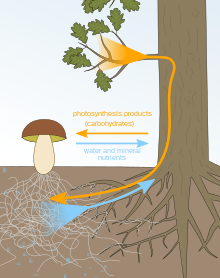Contents
This Is How Mycorrhiza Works Properly
Did you know that about 80% of all plants need a partner by your side? In our case, it’s mycorrhiza, which attach themselves to the roots of plants. If you think now: “All right, plant and fungus – let’s go” it could be difficult, because there are countless different varieties of these fungi. The application is simple, if then times the correct ones are found.
Mycorrhiza Briefly Explained
So that’s where the hammer is. However, to understand how your plant comes to the right mycorrhiza, you should build up a little bit of knowledge. I don’t want to annoy you with scientific treatises, but I want to explain briefly what there is and how it works.
Ectomycorrhiza: is the most common symbiosis with plants and trees in forests. The fungus grows around the root and at most penetrates the root bark. The fungi replace the fine hair roots of the plant.
Endomycorrhiza: The hosts are mainly herbaceous plants (heather, wintergreen, orchids, to name a few). These fungi form a type of sucking organ to deliver nutrients and water to the plant. These fungi grow into the root cell.
Arbuscular Mycorrhiza: This is the most common type of fungi. Pretty much all plant genera are included there. These fungi also invade the cell and form a kind of root tree there. This is also the fungal genus that is very common among herbs.
The Appropriate Selection
Although this all still sounds quite complicated, you already realize that not every mushroom can with every plant because of its properties. Even if you know your plants, it is still very difficult to find suitable mycorrhizae from a dealer. A dealer who once wanted to sell me mycorrhiza advertised it as “fungus and fertilizer in one”. Upon closer inspection, I found that the fertilizer had some fungicidal properties.
You can see where this is going. I still have a say in these matters. You as a customer who has heard something about mycorrhiza can be sold anything in such a case. Then, if something doesn’t work, they will tell you that it can only be you. Therefore, you should ask your salesman precise questions. You will quickly realize if there is a serious dealer behind this. These exist in any case and should also have their price.
For exactly this reason I do not offer cultivated or cultivated mycorrhizae. Also, even institutes like “Agroscope” in Switzerland are far from the end of research.
Simple Is Different
At least in my philosophy. I mix a healthy mix of all plant life into my compost. From forest greens, garden greens and commercial greens, a wide variety of mycorrhizae are naturally cared for and nurtured in my compost.
As you could read in my compost guide, I have planted special plants and trees near my compost for this purpose. For many years I have done exactly these experiments and created such a simple working product with my Terra Anima© Humus Soil and Terra Anima© Vine Soil.
If you want to acquire this knowledge yourself, I highly recommend this book by Peter Wohlleben, which you can purchase here at Amazon, among other places:
The Secret Life of Trees
In my humus soil there is a balanced mix of different mycorrhiza species and soil organisms, so that your plant will always find a partner for symbiosis. Furthermore, the mycorrhiza fungus needs bacteria with which it lives in symbiosis. But this is going too far now.
In my humus soil the complete range of fungi is present. Your plant will choose exactly the one it needs to enter into a symbiosis. From here on, the suitable mycorrhiza will multiply by itself. Both partners are doing well, if they do not come with the chemical club now.
Conclusion
In conclusion, here is a summary of what makes mycorrhizae so special as partners for the plant:
- Nutrients can be absorbed more quickly. Why, that you now know.
- By growing around the root, a kind of protective field is also built up, which protects the plant from harmful influences.
The hair-fine mycelia (a kind of root) of the fungus, which are finer than the hair roots of the plant, can penetrate even into the smallest cracks and other areas where the plant root has no chance.
Many fertilizers cannot be absorbed by the plant at all. Therefore, the soil needs bacteria and other living organisms that decompose natural fertilizers and make them available for the fungus. Now the plant also has something from it.
In this sense, I wish you good luck. If you have any questions or comments do not hesitate to write me an email or call me.
I will be happy to read your opinion and experience on the subject in the comments. Also, it helps me a lot if you are satisfied with my products or information, leave a review on Google.


